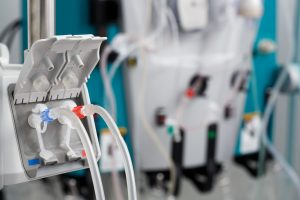Time-Domain Terahertz Sensing Does a Better Job Measuring Critical Product Parameters in Medical Tubing
As the demand for more complex, precisely controlled medical tubing increases, it is increasingly important to have monitoring methods that can provide the full range of product information necessary for the manufacturers to profitably manufacture and validate their products.
Most high-performance medical tubing products are produced by extrusion processes. A hopper of raw polymer pellets feeds into a heater element to melt the material to a liquid form. The liquid polymer is then forced, using a threaded screw, through a die to create the tubing.

The formed tube is kept at a constant extrusion rate and tension, while either passing into a vacuum sizing chamber or with pressurized air pumped into the lumen space, to prevent the still hot low-strength tubing walls from collapsing. The product dimensions are set at this step. The product is typically passed next through a cooling bath. This process is used to create both single layer and multilayer tubing products.
Typical monitoring of the critical product parameters – single and multilayer wall thickness, concentricity, outside diameter (OD) and inside diameter (ID) – is performed by a combination of laser gauges for dimensions and ultrasound for wall thickness measurements.
Ideally, the closer the measurements are made to the extruder, the more responsive the whole system can operate and quickly correct for variations in product.
However, ultrasound measurements require contact with the sample through a couplant. The water in the downstream cooling tanks functions well for this purpose. However, ultrasonic methods can only measure the contact surface; measurement on the opposite tubing wall is not possible without adding more sensors. Laser systems, outside of the cooling tank, are combined with the ultrasound thickness results to provide dimensional measurements.
An ideal sensor would measure all the critical product parameters with better precision, provide simultaneous multilayer measurements (especially for thinner layers and smaller diameter products), be non-contact, have a very fast measurement rate and be completely safe.
A time-domain terahertz sensor can make very fast and high-precision measurements of these parameters with a single non-contact reflection sensor unit. The measurement concept is like ultrasound while operating in air and other locations ultrasound cannot.
A Terahertz (THz) sensor emits a very narrow completely safe low-energy pulse, which travels through air. Therefore, the probe is non-contact and operates with long standoff distances (25mm, 75mm or 150mm). All materials used for tubing and catheter coatings are transparent to THz.
The emitted THz pulse will reflect off interfaces in the sample, such as the air/outer wall and the internal interfaces between materials in a multilayer wall. The Time-of-Flight (ToF) between the reflections is measured, and the layer thicknesses are calculated from these values.
Measurements are collected at a rate of up to 1000 Hz. The THz beam spot size is approximately 2 mm. Measurement precision as high as ±0.5 micron has been obtained.
To learn more about a better on-line measuring and control solution, read our Tubing THz Applications Note now.